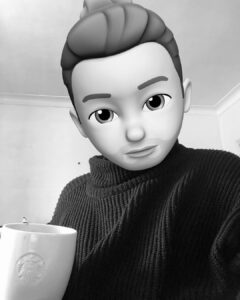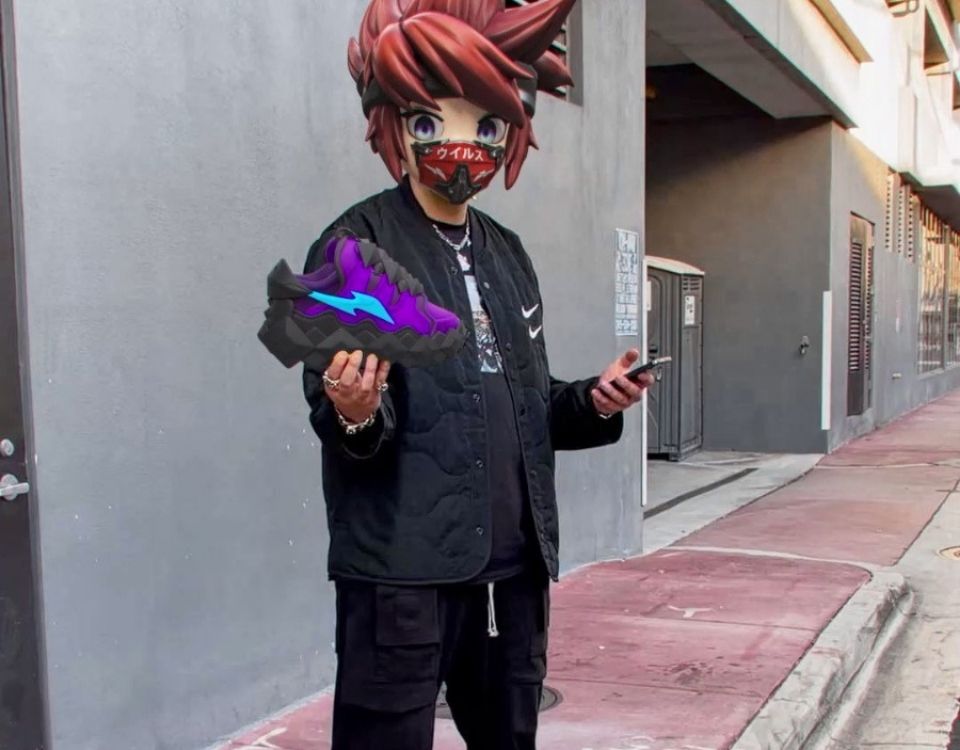The virtual world is still a very new territory for all of us and we are constantly debating on how to set the law and order for the new world. While the real world is exhausted from chasing after the physical and social “perfections” — an illusion created by social media and the behind-the-scenes marketers. How do we avoid the same problems while creating new lives for the virtual world? Richard Thornn HUM.AI.N project seem to tackle these challenges.

Richard Thornn HUM.AI.N Project
Known as the “fashion spider”, Richard Thornn is a fashion tech entrepreneur and creative director based in digital but operates on LDN GMT. He founded 3 entities with co-founder Oksana Kukla to shape the fashion industry’s future for the better, virtually and IRL. The 3 entities are NAMESldn – a PR company that empowers emerging designers with a futuristic vision; SUMB0D1 – a virtual event production house with sustainability in mind; and Richard Thornn HUM.AI.N project- a virtual model agency that empowers the presence of marginalized real humans in the digital world. Some of his past clients include Lady Gaga, Rhianna, Luis De Javier, Harry Styles, Duran Lantink, Elzinga, The Black Eyed Peas & Paloma Faith. Some of his recent projects, such as the Black Lives Matter virtual showroom and his portfolio of diverse models, have received many recognitions from top magazines and social media platforms.
Richard does not only weave fashion with technology to help the existing fashion businesses to run more sustainably in the real world; he also creates meaningful projects that empower diversity and inclusivity in the virtual world. Let’s untangle the webs of Richard’s train of thoughts.

Creating Diversity & Inclusivity in the Virtual World
While everyone else is trying to create the “best” version of humans, Hum.ai.n chose to create the marginalized people in real life…Why do you want to create diverse models?
RT: Technology itself is flawed. Technology is developing itself, but at the minute, it needs us humans or us the creators to help show it what to do.
We, as a human race, are so beautiful, and I want to shine a light on that. If someone is an amputee or has different skin tones, I want that to be embraced and celebrated in the virtual world. I don’t want to be a 7 feet neon green model or avatar with 40 eyes myself. I’m just trying to show the world that everyone should and could be represented in some way or form.
Who are your inspirations when creating these perfectly imperfect digital humans Richard Thornn HUM.AI.N project? How do you determine what kind of characters and characteristics when you build them?
RT: I took inspiration from these models based on real people (like Winnie Harlow), and I also make up fictional characters. Because I am not ethnic or have these conditions, so for me to appropriate each character, I always go to a couple of friends who are a part of the ethnicity/condition and ask for their opinions on how to complete a character’s story. I always give the digital models “real” identities such as real names and birthdays, and star signs, so people treat them in the digital world just like the others.
Do you use AI technology to work with these models?
RT: We’re very conscious about carbon footprint; we want to create varieties of movement styles for real models, so carbon emissions from models traveling would decrease.
Right now, our models are created using off-the-shelf software like C4D, Z Brush, Adobe Suites, Clo, etc. But the tech still needs improvement on creating realistic looks and movements.
On the Fashion Industry
I agree with your past statements about the current fashion industry – “Currently, it’s just become a commodity, a slave to social media and influencers,” Are you trying to solve this with hum.ai.n? How can innovators upgrade it to be more pleasurable and valued?
RT: Hard question. Hum.ai.n is giving people the options to choose to be whoever they are in the virtual world. I think that’s where the pleasure and value will start coming out to me when we’re not trying to fabricate or make our digital models perfect. I understand that we edit our lives through other social media platforms to only show the good qualities. We should be embracing everything to avoid ruining the digital world with the narcissistic, masculine toxicity that I think we’ve all grown up with that we’re trying to break down.

“You mentioned that fashion is missing that “storytelling factor.” I agree with how today’s fashion is struggling with showing authentic emotions. How do you think we can improve that?
RT: Fashion shows have lost their meaning and lost their storytelling ability because of how the world is operating; people just want more and more. The fashion show calendars that we are still abiding by is a vicious cycle, and the digital world allows us to slowly break away from that. The digital doesn’t have four seasons; therefore, it doesn’t have to rely on the weather.
With the SUMB0D1 platform, we are able to focus on delivering the story by creating a 4D experience. The virtual interactions with the virtual space create more emotions and feelings than a real runway show where people can’t interact with the garments much.
How do you see innovators disrupt the current loop?
RT: I think we will need to take baby steps. We can truly disrupt the loop when we are able to dress humans digitally and have influencers promoting digital fashion applications as a norm. An example scenario would be when people want to buy the same outfit as an influencer they like; they don’t necessarily have to own it in real life; they can just own them virtually. And that is more green, less work for everyone.
Seasons in fashion weeks is another challenge that we have in the fashion industry. We are no longer working around the real seasons that we experience. Promoting storytelling campaigns that are not relevant to the consumers’ lifestyle will not sell or provide a great experience.
We shall also empower emerging creators from non-top colleges. The labels of big names and big colleges are taking over the world. But there are so many creatives that are buried under their spotlight.

About Richard Thornn of Hum.ai.n
What or who inspired you to do what you are doing now?
RT: I am not inspired by any person or thing in particular. I’ve always been coined as a “fashion spider,” I’m all about connecting different people together and collecting inspiration from people and objects and things and regurgitating it.
Did you come from a tech or design background?
RT: I went to an art school, then did a fashion design MA in Kingston, and I met and worked with my MA tutor, who had a technology company. So I know the terminology in electronics, self-taught with the basics like battery work and soldering. I’ve also done physical fashion shows and PR, which then I realized that I sit nicely in the grey space that can communicate to both fashion and tech sides.
What’s your relationship with technology? How dependent are you on technology in your daily rituals?
RT: I’ve got 20 odd so different screens open desktop, multiple laptops, phones, my whole world is connected, and my house operates on renewable energy. I’ve got robots to clean my floor, the doorbell to be my eye, and even my food is 3D printed! There are those tailor-made 3D printed stackable vitamins based on your quiz results. So I would say my relationship with technology is 100%, and I love it. But with all things, you have a love & hate relationship.

On Richard’s Opinion of the Future
What do you think the impact of digital human models will be? Do you think we will live in a world like a movie HER or TV show Black Mirror?
RT: I think TV and film are like little teasers for what the future could and will be. I’m sure when we first got Alexa, Google Home, or Apple Home, we were all terrified of computers taking over. But now I think we’ve accepted it because films like Back to the Future or Black Mirror have allowed us to see that coming in the future in small doses.
People should stop being so scared that computers are taking their jobs away. The computers are not. You need to rethink how to transfer your skills into that digital world.
Are you personally excited to live in that kind of world?
RT: Yes, I’m all for it. I will be super okay if you want to make me a cyborg today.
What’s your opinion on the future of digital humans, including models by Richard Thornn HUM.AI.N project? Do you think they will take over the model world?
RT: As we move more into the roaring tech 20s, we will start to see technology really being developed at a fast pace. If we continue to be sitting in front of our screens, people will want a way of escaping, and technology will allow that. So I think it’s going to be interesting to see how the two worlds really do collide.
What projects are you working on right now? Any projects we should be bookmarking for?
RT: We have just released ‘MAVRA,’ a campaign that marries both the online and offline environments by taking the best aspects from each space to create a complete and satisfying reality for the fashion industry. With advanced cinematography technology, this new way of creating digital fashion, by blending physical and digital fashion content, allows the audience to be transported mentally into a different virtual world. This way, everyone is in a “digital front row” – allowing inclusivity for all.
You can check it out here: Alvaro Mars x SUMB0D1
And finally – on the scale of HYBRIDITY(mix between organic and tech), where do you think your brand is currently placed at?
- Please choose a number between 1-100, provide 2 decimal numbers for accurate representation. There are no good or bad numbers. This number is also fluid, we will revisit every year for you to update.
- Benchmarks numbers:
- 1= Total organic, focusing on form and design
- 50 = Total hybrid
- 100 = Total tech, focusing on function and technological development
RT: I’m definitely an 80% tech, 20% organic – but if you can upload me to the cloud. Where do I sign!!!
Would like to contribute or share your new innovation with us? SAY HELLO TO US








